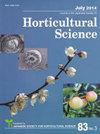Effect of Localized Promotion of Cytokinin Biosynthesis on Flower Morphology in Flower Buds of Torenia fournieri Lind.
Journal of The Japanese Society for Horticultural Science
Pub Date : 2013-10-01
DOI:10.2503/JJSHS1.82.328
引用次数: 1
Abstract
To analyze the relationship between flower morphology and organ-specific promotion of cytokinin biosynthesis within flower buds, we introduced Arabidopsis isopentenyltransferase 4 (AtIPT4) into torenia (Torenia fournieri L.) under the control of APETALA1 (AP1) or APETALA3 (AP3) promoter. AP1::AtIPT4 plants had an increased number of petals, whereas AP3::AtIPT4 plants had an expanded corolla, a paracorolla, and serrated petal margins along with an increased number of petals. In AP3::AtIPT4 plants, marked receptacle enlargement was observed when the flower buds were in the early corolla development stage in which the paracorolla primordia differentiate. As expected, AtIPT4 was expressed in the sepals and petals of AP1::AtIPT4 plants, and in the petals and stamens of AP3::AtIPT4 plants. Furthermore, the type-A response regulator (TfRR1) and cytokinin oxidase (TfCKX5) genes, which were used as indices of cytokinin signal, showed the same expression patterns as the transgene. These findings indicate that expansion of the corolla and development of the paracorolla and serrated petal margins after receptacle enlargement in AP3::AtIPT4 plants are induced by localized elevated cytokinin signal in the petals and stamens. In contrast, localized elevated cytokinin signal in the sepals and petals only induced an increase in the number of petals. Therefore, an elevated cytokinin signal in the stamen may be important for inducing corolla expansion and for developing a paracorolla and serrated petal margins.局部促进细胞分裂素生物合成对褐花花蕾花形态的影响。
为了分析花形态与器官特异性促进花蕾内细胞分裂素生物合成的关系,我们在aptala1 (AP1)或aptala3 (AP3)启动子的控制下,将拟南芥异戊烯基转移酶4 (AtIPT4)引入到托伦(torenia fournieri L.)中。AP1::AtIPT4植株花瓣数量增加,而AP3::AtIPT4植株花冠扩大,副花冠,花瓣边缘呈锯齿状,花瓣数量增加。在AP3::AtIPT4植株中,花蕾处于花冠发育早期,花冠旁原基分化,花托明显增大。不出所料,在AP1::AtIPT4植株的萼片和花瓣以及AP3::AtIPT4植株的花瓣和雄蕊中都有表达。此外,作为细胞分裂素信号指标的a型反应调节因子(TfRR1)和细胞分裂素氧化酶(TfCKX5)基因的表达模式与转基因相同。这些结果表明,AP3::AtIPT4植株花托扩大后花冠的扩大、副花冠和锯齿状花瓣边缘的发育是由花瓣和雄蕊中细胞分裂素信号的局部升高诱导的。相反,萼片和花瓣中细胞分裂素信号的局部升高只导致花瓣数量的增加。因此,雄蕊中细胞分裂素信号的升高可能对诱导花冠扩张、副花冠和锯齿状花瓣边缘的形成具有重要意义。
本文章由计算机程序翻译,如有差异,请以英文原文为准。
求助全文
约1分钟内获得全文
求助全文
来源期刊
自引率
0.00%
发文量
0
审稿时长
>36 weeks

 求助内容:
求助内容: 应助结果提醒方式:
应助结果提醒方式:


